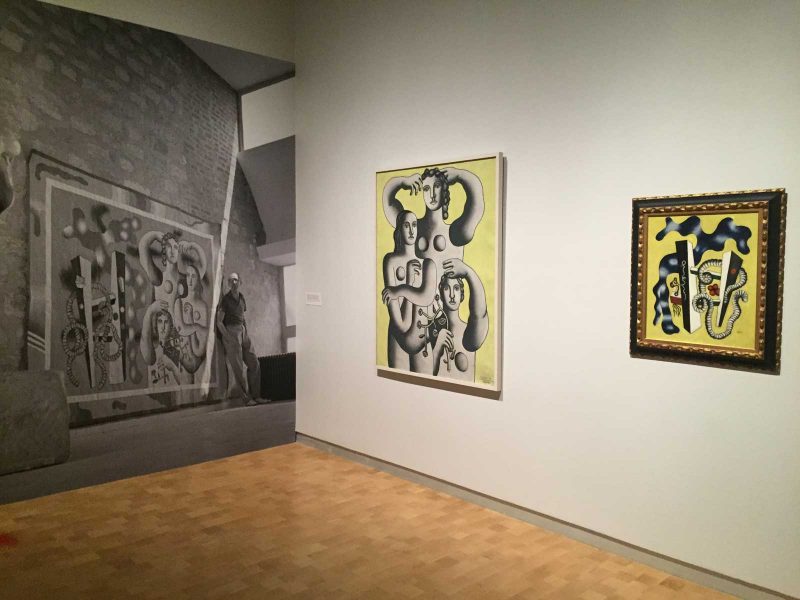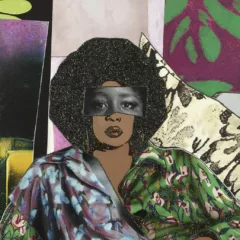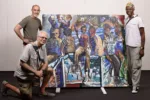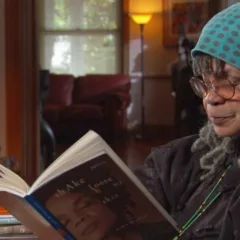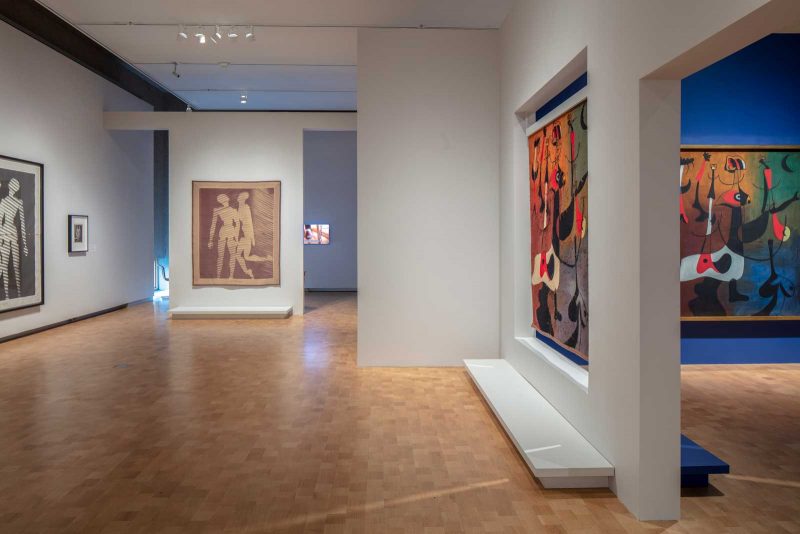
Museums are reopening! Hooray! For those of us who have been cooped up and counting down to some sense of “normalcy” in the world, the reopening of cultural institutions in Philadelphia is a great start. While a visit may look a little different, I think that museums in the time of COVID are actually pretty nice: spacious, quiet, and very intimate. Marie Cuttoli: The Modern Thread from Miró to Man Ray absolutely benefits from this forced gallery experience. The exhibition was originally set to close in May, but was extended to contend with COVID closures – how lucky that it was for those of us that didn’t get a chance to see it before!
The exhibition centers around Marie Cuttoli’s groundbreaking vision of the relationship of art with everyday life in the form of decor (that is, “everyday life” in terms of those who could afford such finery). Cuttoli was always interested in fashion and design. She spent many years commissions rugs made by Algerian women, which she sold to Parisian fashion houses. Being rich certainly helped this enterprise, and supported her adjacent career in fashion – Marie had her own designer label, Myrbor. Cuttoli later used her expertise with textiles to commission tapestry designs from such heavy-hitters as Pablo Picasso, Man Ray, Georges Braque, and more, which she distributed to wealthy clientele. As her practice gained notice, she expanded, using the historic tapestry workshops in Aubusson, France, to further merge art, design, and business. Through her collaboration with artists and her business mind, Cuttoli brought current artists into the homes of new art appreciators. This incredible history is made all the more relevant to a Philadelphia audience by the fact that Dr. Barnes was one of Cuttoli’s biggest advocates – a selection of their correspondence can be seen on view in the show, amongst paintings, drawings, and final tapestry works.
The exhibition, curated by Barnes Foundation associate curator Cindy Kang, thus takes a very intimate approach to Cuttoli’s practice, and the artists’ work. Moving through Cuttoli’s passionate relationship with the art objects, the exhibition is divided into many small rooms, cradling visitors and giving us a chance to look closely and see the direct relationship between painting/ drawing and textile product. In the galleries, the limited capacity forced by COVID made the experience, for me, more magical. How many times have people gone to special exhibitions and felt so crowded that you spent more time wading through other visitors than looking at the art?
The first room of the exhibition focuses on Myrbor. The materiality of the dresses – their textures, colors, and the hand-made care – sets up visitors for what is to come in the rest of the exhibition. The next room was one in which I spent a long time, as it featured two pairs of paintings and tapestries from Georges Rouault which illuminated the painting-textile relationship beautifully. I was fascinated to see how the c. 1933 painting “The Little Family” translated from an oil painting to a wool and silk tapestry. Like a block print, the image was inverted from painting to textile. In fabric, the colors were dampened, and a border had been added to the design. I was enamoured at this translation. Cuttoli herself spent much of life living between Algeria and France, transitioning between two cultures. I felt that seeing the pairs of works in the exhibition was another way to think about a state of translation, transition, or transmutation.
The next work that really caught my eye was Picasso’s “Minotaur (Minotaure)” (1935). The tapestry was in muted, earthy colors, and maintained the same sense of collage found in Picasso’s paintings. In his design for Cuttoli, Picasso specifically collaged different kinds of paper that emulated fabric. In its transition from paper to weaving, the process was inverted: the makers then matched fabric to the look of the paper (which had matched the look of the fabric). I was amused by the material matching the subject: a merging of man and bull, paper and thread.
The middle part of the exhibition repeated these discoveries with different artists: how blue becomes muted from paint to wool; or the detail of thread upon thread matching a strange Man Ray work. There was a fascinating video about the process of tapestry creation, and a large range of ephemera, like letters, catalogues, and telegraphs to and from Madame Cuttoli. The flow was organic, and the wall text was illuminating at every turn – helpful for me, a viewer coming in with highly limited knowledge of decorative arts and their creation process. The exhibition wove together (forgive the pun) art and commerce effectively – mixing the physical objects with large photo reproductions of businesses and homes where the tapestries were presented.
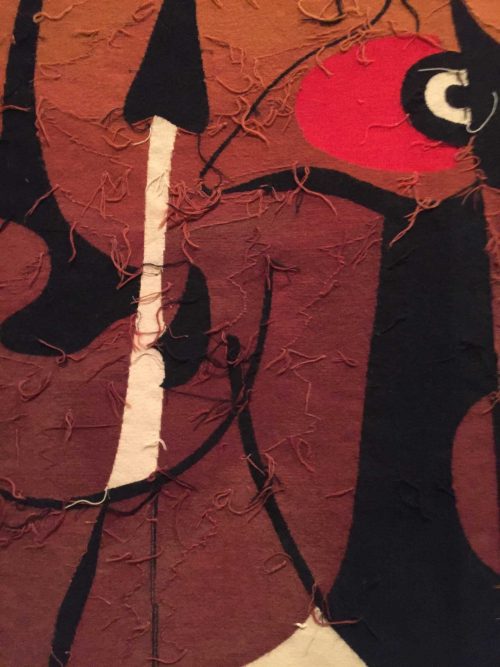
Perhaps the best part of the exhibition, and the most effective curatorial choice, was the finale. The last room of the show, painted with a rich blue tone on the walls, focuses on the work of Joan Miró. This room stands out not only because of the scale (it features 2 huge paintings, one giant tapestry, and a full-wall photo reproduction), but also the opportunity to get a the close-up look at the tapestry itself. To enter the final room, you first pass by the exposed back side of “Rhythmic Figures (Personnages rythmiques) or Woman with Birds” (painting and tapestry 1934). At first, you may not understand what you are looking at, but when you enter the blue room, and see the front side of the work, next to the painting upon which the design is based, you are immediately drawn back out, to take a closer look at the back. The back is rife with tied-off threads, unlocking the mystery of the front of the tapestry, giving us some clue as to its making, and the original colors. The back more closely matches the painting: protected against the wall, the colors have remained much more vibrant than the tapestry’s front; and the image orientation matches that of the painting, rather than the mirrored orientation of the tapestry’s face. It is the only piece in the exhibition of which you can see both sides, which both highlights the materiality of the fabric, while also inducing a further sense of wonder at the creation of these objects. This mix of wonder and closure is a fantastic way to end the exhibition: providing a well-known artist, giving us giant objects, showing us the mystery of the back, and leaving us with some questions answered and others newly opened for further contemplation. The room also provides the perfect marriage of Cuttoli’s version of merging art and business, through a label describing how, in the late 1950s, the Seagram building in NYC acquired a set of Miró tapestries.
This exhibition not only serves as a balm for COVID-restrained art lovers, but also opens up a bridge between art, design, and the various mediums used to create and translate art objects. The colors, textures, and palpable passion that is present from room to room automatically recommends itself to visitors, and the museum’s COVID limitation of allowing about 35 people in the show at one time only heightens the experience. After taking a walk through this exhibition, I highly recommend you make your way through the permanent collection – you might just see Dr. Barnes’s vision of the space differently after looking at art and design through the eyes of Marie Cuttoli.
Marie Cuttoli: The Modern Thread from Miró to Man Ray
The Barnes Foundation
February 23 – August 23, 2020
